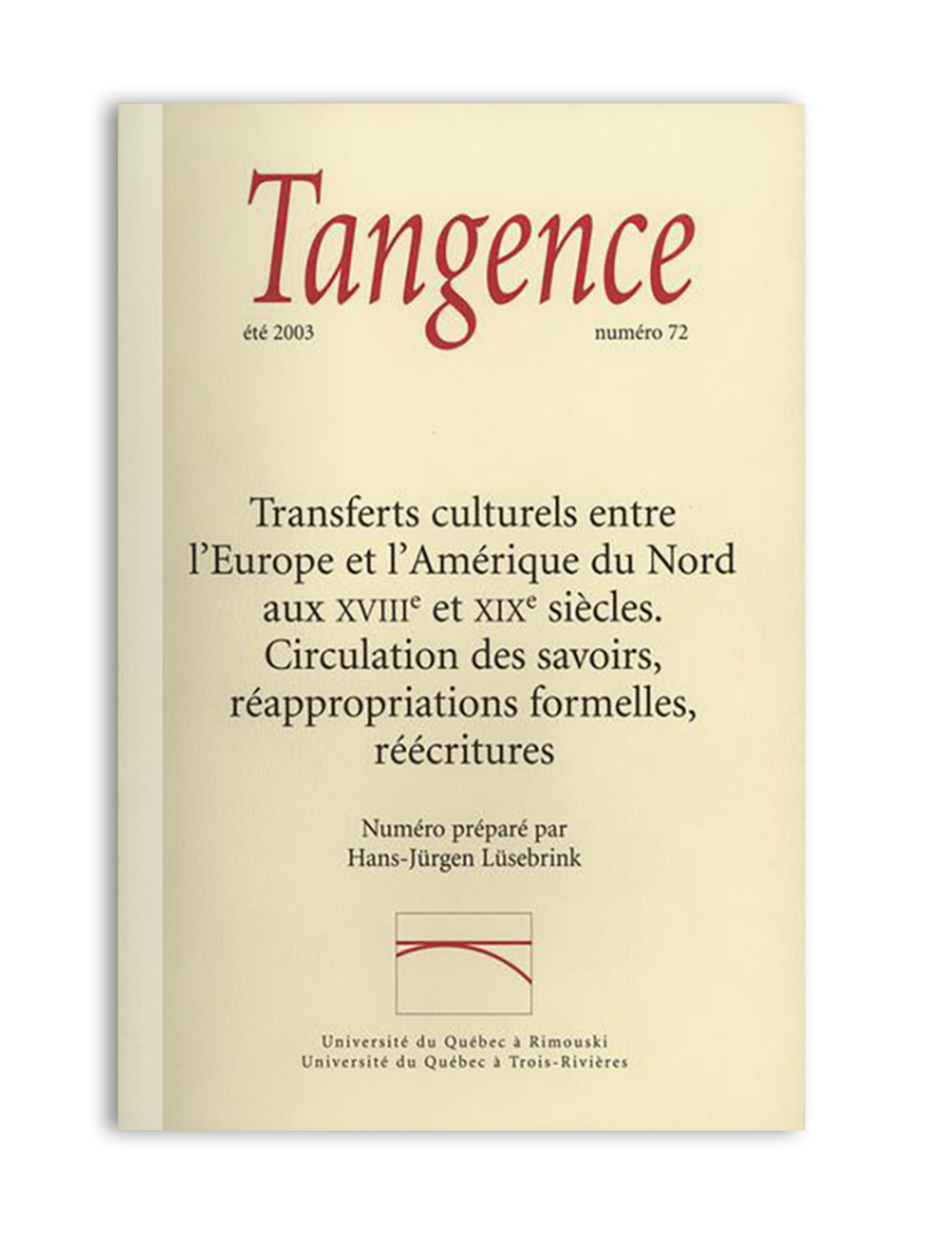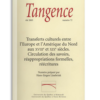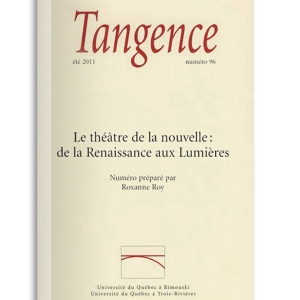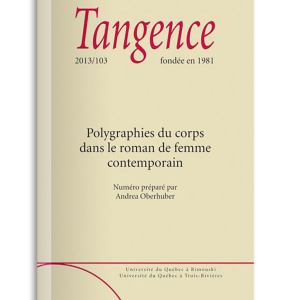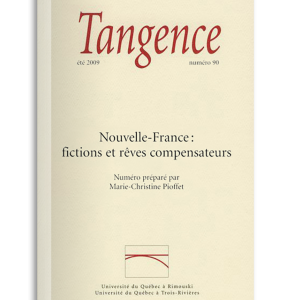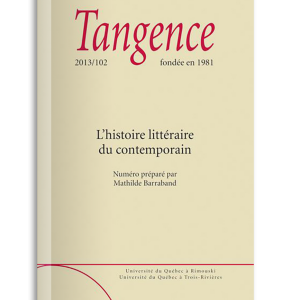N° 72, été 2003
Transferts culturels entre l’Europe et l’Amérique du Nord aux XVIIIe et XIXe siècles.
Circulation des savoirs, réappropriations formelles, réécritures
Stéphanie Massé
De l’actio oratoria à la tribune de l’orateur canadien (1793-1840)
Les premiers orateurs canadiens ont été formés dans les collèges du Bas-Canada où les maîtres de rhétorique faisaient de l’exercice d’une parole éloquente le fondement de leur enseignement, suivant en cela les préceptes dispensés jadis par Cicéron et par Quintilien. Du nombre de ces préceptes, il faut souligner le rôle éminent de ceux qui touchent à l’actio oratoria, c’est-à-dire à la mise en scène du corps parlant. L’actio importe d’autant plus que son étude survient au terme d’un cursus scolaire que venaient couronner soit des exercices oratoires, soit la représentation d’une pièce de théâtre. Cet article interroge, à la lumière de cette tradition et de ces exercices, les descriptions des performances oratoires dont ont été le théâtre la Chambre d’assemblée ou encore la tribune de l’orateur à la veille des Rébellions. Ces comptes rendus formés d’archives, de journaux et de documents iconographiques constituent autant de témoignages susceptibles de mettre en évidence une poétique du geste, apprise dans les collèges et réinventée sur la scène publique.
From the actio oratoria to the Forum of the Canadian Orator (1793-1840)
The first Canadian orators were formed in the colleges of Lower Canada, where masters of rhetoric made the exercise of eloquent speech the basis of their teaching, thereby following the precepts of Cicero and Quintilian. Of these precepts, we must emphasize the eminent role of those concerning the actio oratoria, that is, the performance of the speaking body. The actio was all the more important in that its study occurred upon completion of an academic course capped by exercises in public speaking or the staging of a play. In light of this tradition and these exercises, this article describes the public speaking performances that took place in the Chambre d’assemblée and the speaker’s forum on the eve of the Rebellions. These accounts from archives, newspapers and iconographic documents constitute pieces of evidence that highlight a poetics of gesture learned in the colleges and reinvented in the public arena.
***
Hans-Jürgen Lüsebrink
Transferts culturels transatlantiques et circulation des savoirs dans les cultures populaires — le cas des almanachs de Benjamin Franklin
S’il est vrai que l’almanach populaire constitue, pour l’analyse des transferts culturels transatlantiques aux XVIIIeet XIXe siècles, un genre socialement très important, mais en même temps peu exploré, trois questionnements s’imposent à partir de l’exemple choisi des almanachs de Benjamin Franklin. Il s’agit d’interroger, d’une part, le succès éditorial du Poor Richard’s Almanack, de ses extraits et de ses traductions des deux côtés de l’Atlantique ; d’autre part, les formes de réception complexes visibles dans cette étude de cas, comportant comme versant essentiel la dimension à la fois intraculturelle (l’appropriation par Franklin de nombreuses références, notamment de la culture d’élite, dans ses almanachs) et interculturelle (les formes de transferts de ses almanachs dans d’autres cultures). Enfin, pour finir, il importe de questionner aussi bien la présence des figures de narrateur créées par Franklin que le personnage de Franklin lui-même — qui apparaissent comme inextricablement liés — dans les almanachs européens et canadiens-français.
Transatlantic Cultural Transfers and the Circulation of Knowledge in Popular Cultures — the Case of Benjamin Franklin’s Almanacs
If it is true that, for the analysis of transatlantic cultural transfers in the eighteenth and nineteenth centuries, the popular almanac constitutes a socially important though little-explored genre, three issues must be examined based on the chosen example of Benjamin Franklin’s almanacs : first, the editorial success of Poor Richard’s Almanack and its extracts and translations on both sides of the Atlantic ; second, the complex forms of reception visible in this case study, including the essential aspect of the intracultural (Franklin’s appropriation of numerous references — notably the culture of the élite — in his almanacs) and intercultural (the forms his almanacs took in other cultures) dimension ; and finally, the presence of the narrative figures created by Franklin as well as the person of Franklin himself — which appear inextricably related — in European and French Canadian almanacs.
***
York-Gothart Mix
Ubi libertas, ibi patria : les échanges interculturels dans les calendriers germano-américains aux XVIIIe et XIXe siècles
Les seuls travaux relativement récents qui proposent un point de vue d’ensemble sur les relations littéraires entre l’Amérique du Nord et l’Allemagne n’ont pas tenu compte d’une importante source textuelle pourtant inscrite au cœur du discours social le plus quotidien et étroitement liée aux questions d’identité et de différences culturelles : celle des calendriers populaires allemands publiés en Pennsylvanie à partir de 1731 et ailleurs en Amérique du Nord. Un tel corpus définit quatre objets qui seront de la plus haute importance pour toute recherche future. Il s’agit d’étudier d’abord les caractéristiques spécifiques du média et les différences génériques qui s’expriment dans le calendrier germanoaméricain ; deuxièmement, l’ensemble des modèles identitaires véhiculés par ces périodiques ; troisièmement, les formes possibles de communication interculturelle ; et, finalement, la relation entre adaptation culturelle et autonomie.
Ubi libertas, ibi patria : Intercultural Exchanges in German-American Calendars in the 18th and 19th Centuries
The only fairly recent general works investigating the literary relationships between North America and Germany do not account for an important textual source placed at the core of daily discourse and dealing with questions of cultural identity and differences : the German popular calendars published in Pennsylvania (from 1731 onward) and in other parts of North America. Such a research presents four topics that will be of utmost importance to future research. First, we will have to investigate the media-specific characteristics and genre differences manifest in the German-American calendar ; second, the collective patterns of identity encapsulated in these periodicals ; third, the possible forms of intercultural communication ; and, finally, the relationship between cultural adaptation and autonomy.
***
Clorinda Donato
Le Nouveau Monde et l’apologie du catholicisme dans le Dictionnaire de théologie (1789-1790) de l’abbé Bergier
À la fin du XVIIIe siècle, au moment où la Révolution semble avoirenfin écrasé « l’Infâme », paraît une apologie du catholicisme qui sut réinventer l’art de défendre et d’illustrer l’Église en fonction d’un nouvel ensemble de critères et de savoirs. Avec l’abbé Nicolas-Sylvestre Bergier, apologiste de renom dont la réputation s’était affirmée dès les années 1760 à l’occasion de fines analyses des textes des philosophes, les méthodes inspirées de celles des encyclopédistes et les connaissances tirées de l’exploration du Nouveau Monde s’allient en faveur d’un discours apologétique renouvelé destiné à combattre l’ennemi protestant ou libre penseur. C’est ce dont témoigne en particulier son Dictionnaire de théologie, ouvrage de compilation commandé par Panckoucke pour l’Encyclopédie méthodique. L’examen d’une série d’articles centrée sur le rôle des missions catholiques dans le monde met en évidence la compatibilité, voire l’étroite complicité, entre la mission apostolique des Jésuites, la mission d’exploration, la collection et l’expansion des savoirs à une époque où s’annoncent la fin des Lumières et celle des premiers empires coloniaux.
The New World and the Apologia for Catholicism in Abbé Bergier’s Dictionnaire de théologie(1789-1790)
At the end of the eighteenth century, at a time when the Revolution seemed finally to have crushed « the infamous thing, » an apologia for Catholicism appeared that was able to reinvent the art of defending and explaining the Church thanks to a new set of criteria and knowledge. With Abbé Nicolas-Sylvestre Bergier, a renowned apologist whose in-depth analyses of the texts of the philosophes established his reputation in the 1760s, methods inspired by those of the encyclopédistes together with knowledge drawn from explorations of the New World produced a renewed apologetic discourse intended to combat the Protestant, or freethinking, enemy. This is particularly apparent in his Dictionnaire de théologie, a compilation ordered by Panckoucke for the Encyclopédie méthodique. The study of a series of articles centred on the role of Catholic missions in the world underscores the compatibility — the tight complicity even — between the apostolic mission of the Jesuits, the mission of exploration, and the acquisition and expansion of knowledge during an age characterized by the end of the Enlightenment and the beginning of the first colonial empires.
***
Julie Boch
L’Occident au miroir des sauvages : figures du païen chez Fontenelle et Lafitau
Étudier les peuples lointains pour définir les principes de l’esprit humain ; décrire le paganisme contemporain pour comprendre celui des nations anciennes, puis éclairer la nature de la religion chrétienne : tel est le projet que formèrent, tous deux en 1724, Joseph Lafitau, auteur des Mœurs des sauvages américains, comparées aux mœurs des premiers temps, et Fontenelle, dans son traité De l’origine des fables. Le premier, jésuite qui avait séjourné dans le Nouveau Monde, cherche à prouver la rémanence universelle de la révélation faite par Dieu aux premiers hommes, déformée mais jamais perdue au fil des avatars des croyances humaines. Le second, rationaliste sceptique soucieux de remettre en cause les dogmes établis, veut au contraire discréditer la croyance religieuse en montrant que son fondement est intrinsèquement lié au mythe. Ces perspectives divergentes utilisent pourtant la même méthode : la réflexion sur le christianisme se développe à partir d’une comparaison entre les sauvages d’Amérique du Nord et le peuple qui fonde la civilisation occidentale, les Grecs de l’Antiquité.
The West in the Mirror of Primitive Peoples : Figures of the Pagan in Fontenelle and Lafitau
To study the peoples of ages past in order to define the principles of the human spirit ; to describe contemporary paganism in order to understand the paganism of ancient nations, then clarify the nature of the Christian religion : such was the project issued in 1724 by two men — Joseph Lafitau, author of Customs of the American Indians Compared with the Customs of Primitive Times, and Fontenelle in his treatise De l’origine des fables [On the Origin of the Fables]. The former, a Jesuit who had spent time in the New World, seeks to prove the universal persistence of God’s revelation to the first humans, a revelation deformed but never lost amid the permutations of human beliefs. The latter, on the other hand, a sceptical rationalist anxious to re-examine established dogma, wishes to discredit religious belief by demonstrating that its foundation is linked intrinsically to myth. But these differing perspectives employ the same method : the meditation on Christianity is based on a comparison between the native Indians of North America and the people who founded western civilization, the ancient Greeks.
***
Pierre Berthiaume
Abaquis et Nopandes, ou l’Herméneutique inversée du Philosophe anglais de Prévost
À deux reprises, dans Le philosophe anglais, Prévost met en scène une utopie fondée sur un transfert culturel. Les réformes imposées aux Abaquis par Cleveland, tout comme celles à l’origine de l’évolution des Nopandes, reposent sur l’inscription de la raison au sein de la sauvagerie américaine. Mais, chez les Abaquis, le transfert n’est opératoire qu’après que Cleveland se soit approprié leur culture pour la détourner à son profit et, chez les Nopandes, il constitue le point aveugle de leur passé. Dans le roman de Prévost, l’Autre est l’objet d’une expérience culturelle qui démonte la mécanique de l’aliénation des hommes. En même temps qu’il fait appel à la raison pour faire évoluer les Abaquis, Cleveland met à profit leurs superstitions pour asseoir son autorité, qu’il métamorphose alors en théocratie. Chez les Nopandes, l’aliénation, qui constitue le point aveugle de leur histoire, suggère l’impossibilité de tout transfert culturel. Ce que Prévost met finalement en doute, c’est la perfectibilité de l’homme. Ni la nature, toute bonne qu’elle est, ni la raison, si éclairée soit-elle, n’assurent le progrès de l’humanité.
Abaquis and Nopandes, or the Reverse Hermeneutics of Prevost’s Philosophe anglais
In his Le Philosophe anglais [The English Philosopher] (1731), Prévost depicts at two different times a utopia founded on cultural transfer. The reforms Cleveland imposes on the Abaquis, like those that set in motion the evolution of the Nopandes, depend on the imprint of reason in the minds of the native American Indians. But for the Abaquis, the transfer is operative only after Cleveland has appropriated their culture and manipulated it to his advantage, while for the Nopandes, it constitutes the blind spot of their past. In Prévost’s novel, the Other is the object of a cultural experience that dismantles the mechanism of human alienation. At the same time that he calls upon reason to spark the evolution of the Abaquis, Cleveland exploits their superstitions to establish his own authority, which he then transforms into a theocracy. For the Nopandes, alienation, the blind spot of their history, suggests the impossibility of any form of cultural transfer. In the end, what Prévost is questioning is the notion of the perfectibility of Man. Neither nature, however good, nor reason, however enlightened, assures the progress of humanity.
***
Claude La Charité
La Sciomachie (1549) de Rabelais : la « juste quantité d’une epistre » ou l’alibi épistolaire de la propagande épidictique
En publiant sous le titre de Sciomachie (1549) le compte rendu des festivités organisées à Rome par le cardinal Du Bellay à l’occasion de la naissance de Louis d’Orléans, second fils de Henri II, Rabelais prétend fournir un récit « extraict d’une copie des lettres escrites [au] Cardinal de Guise », alors qu’en fait il traduit, en la remaniant et en l’augmentant, la relation italienne d’un contemporain, Antonio Buonaccorsi. L’alibi épistolaire est entretenu dans le corps même du texte, puisque le narrateur se justifie d’abréger son entrée en matière par le souci de ne pas excéder « la juste quantité d’une epistre ». En réalité, il semble que cet alibi épistolaire cherche à inscrire le texte dans le genre de la lettre d’information (epistola nunciatoria) en général et de la lettre de Rome (Romsbrief) en particulier, pour mettre en avant son caractère apparemment véridique et factuel. Même si le souci de la datation et de la chronologie rapproche la Sciomachie de ce type de lettre, le récit s’assimile bien davantage à une lettre démonstrative par le recours aux répétitions symétriques, l’emploi de termes techniques ou les emprunts au latin, au grec ancien et à l’italien, en offrant au besoin des gloses en français courant. En outre, la composition même des descriptions, en particulier de la fausse forteresse construite pour le simulacre de bataille, répond très exactement à la méthode préconisée par Érasme dans son De conscribendis epistolis. C’est que l’alibi épistolaire cherche à donner à la propagande royaliste de la Sciomachie le caractère vraisemblable d’un compte rendu épistolaire d’individu à individu, même si, dans les faits, le récit est destiné au plus large lectorat.
Rabelais’s Sciomachie (1549) : the « Appropriate Length of an Epistle » or the Epistolary Alibi of Epidictic Propaganda
In publishing, under the title Sciomachie, an account of the festivities that Cardinal du Bellay had organized in Rome to celebrate the birth of Louis d’Orléans, second son of Henri II, Rabelais claims to supply an « extract of a copy of the letters written [to] Cardinal de Guise », whereas what he is doing, in fact, is reworking and expanding the Italian report of a contemporary, Antonio Buonaccorsi. The epistolary alibi is continued in the body itself of the text, since the narrator justifies his overly brief introduction to the subject by citing a concern not to excede « the appropriate length of an epistle. » In reality, it would appear this epistolary alibi seeks to position the text within the genre of the letter of information (epistola nunciatoria) in general and the letter from Rome (Romsbrief) in particular in order to emphasize its apparently authentic and factual character. Even if the Sciomachie closely resembles this type of letter due to its preoccupation with dates and chronology, the narrative can be further considered a demonstrative letter because of its recourse to symmetrical repetitions and the use of technical terms or borrowings from Latin, ancient Greek and Italian, along with commentary provided as needed in standard French. Moreover, the very composition of the descriptions, particularly that of the fake fortress constructed for a simulated battle, corresponds quite closely to the method recommended by Erasmus in his De conscribendis epistolis. What the epistolary alibi aims to do is give the royalist propaganda of the Sciomachie the likely character of an epistolary account written from one individual to another, even if the narrative is in fact intended for a wider readership.
***
André Gervais
D’une apostrophe. Lecture d’« Alberts ou la vengeance », nouvelle de Gérald Godin
« Alberts ou la vengeance » (1964) est la première nouvelle qu’a publiée Gérald Godin. Particulièrement chargée bien que de petite surface (4 p.), elle conjoint sur un sujet grave (la vraie paternité) et avec un sens aigu de la dérision un complexe ensemble de liens à lire, depuis celui du texte, sur trois plans, par déplacements : celui de l’intertexte, celui du biographique et celui du référent politique. Cet article tente de s’approcher au plus près de ce qui constitue le nœud de ce texte peu connu.
About an Apostrophe : A Reading of Alberts ou la vengeance, a Short Story by Gérald Godin
Alberts ou la vengeance [Alberts, or Vengeance] (1964) is the first short story published by Gérald Godin. Particularly rich in texture, though short (4 pages), it unites, on a serious subject (real paternity) and with an acute sense of the ridiculous, a complex set of links to be read, from that of the text, by shifts and on three levels : those of the intertext, the biographic material and the political referent. This article attempts to focus as closely as possible on what constitutes the crux of this little-known text.

